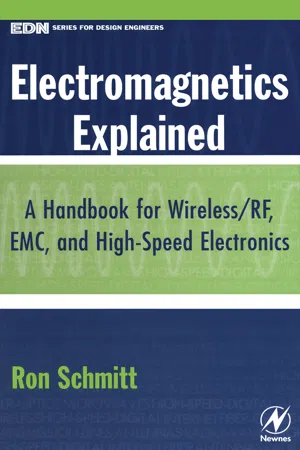Electricity
Electricity is a form of energy resulting from the movement of charged particles, such as electrons. It is a fundamental aspect of physics and plays a crucial role in various natural phenomena and technological applications. The study of electricity encompasses concepts like electric fields, electric currents, and electrical circuits, and is essential for understanding the behavior of matter at the atomic and molecular levels.
7 Key excerpts on "Electricity"
- eBook - ePub
The Big Ideas in Physics and How to Teach Them
Teaching Physics 11–18
- Ben Rogers(Author)
- 2018(Publication Date)
- Routledge(Publisher)
...Many of the philosophers adopted the showmen’s circus style, entertaining friends and society with electric kisses, dangling boys and electrocuting turkeys for thanksgiving. Then came Galvani’s twitching frogs’ legs and animal Electricity. Galvani’s nephew toured Europe, making the recently executed twitch and open their eyes. The idea that Electricity was linked to life was used by radicals in the early 19th century to sermonise against God and the natural order. Then there were the quacks and medical charlatans with their electropathic belts and Pulvermacher’s Galvanic bath chains. So, it is a relief that the word Electricity has fallen into disuse in modern physics, fit only as the title for courses. It is not a word to be used carelessly. The next three words – charge, current and potential difference – benefit from clear explanations, but explanations are not how these concepts are learnt. They are only really understood by answering as many ‘end-of-the-chapter’ questions as possible. It is the exemplars we have learnt that make us physicists. Electric charge Charge is the most fundamental, and the most slippery, of the electrical terms. It is defined as follows: “Electric charge is the physical property of matter that causes it to experience a force when placed in an electromagnetic field” (Wikipedia 2017). The definition alone is hopeless. In physics, the word charge (Figure 1.13) is used in at least three different ways. First, and most important, charge is used as an uncountable noun – physicists often talk about charge as though it were an amount of a substance, like water or plasticine, not separated into separate droplets or chunks. This idea developed because physicists initially understood Electricity as a flow of charge, imagining water flowing in a pipe...
- eBook - ePub
Instrumentation
An Introduction for Students in the Speech and Hearing Sciences
- T. Newell Decker, Thomas D. Carrell(Authors)
- 2004(Publication Date)
- Psychology Press(Publisher)
...1 Introduction to Basic Electricity Almost without exception, when a person decides to use an instrument, it must first be connected to an electrical outlet. Because Electricity is almost always available for our use, we tend to take it for granted, never questioning what it is or from where it comes. There are, however, some fundamental electrical concepts that are important to the overall understanding of clinical and laboratory equipment as it is discussed in later chapters of this book. But even more important, these concepts should be understood in order to operate instruments safely. This chapter contains a simplified discussion of where Electricity comes from, what its basic parameters are, and how it can be used safely. Some simple equations and formulas illustrate the basic concepts, and you are encouraged to study them. ELECTRICAL FIELDS AND CHARGES Atoms are no longer thought of as the smallest particle of an element. We now know that atoms are made up of much smaller particles, some of which are: electrons, protons, and neutrons. Electrons and protons are the stuff of which electrical energy is made. Electrons have an electrical charge with a negative value, whereas protons have an electrical charge with a positive value. Both protons and electrons are of fundamental importance to the presence of Electricity. Because neutrons have a neutral or zero charge, we will not be concerned with them in this chapter. Figure 1.1 demonstrates a basic characteristic of electrical charges. Charges that are of the same value or sign will repel each other; charges that are of dif- FIG. 1.1. Polarity of electrical charges showing that different charges attract and similar charges repel. ferent values or signs attract. Most of us have demonstrated an analogous property to ourselves with magnets. If we hold the south poles of two magnets together and then release them, the magnets jump apart...
- eBook - ePub
- Howard W. Penrose(Author)
- 2014(Publication Date)
- Success By Design(Publisher)
...Insulators include ceramics, glass and mica. Current, Voltage and Resistance Whether discussing the topic in terms of direct or alternating current, the basic elements of Electricity include current, voltage and resistance. Current (I) is the flow of Electricity much like the flow of water in a pipe. It is measured in Amperage as opposed to gallons per minute of water. The measurement of current is standardized as 1 Amp being equal to 6.28 × 10 18 electrons passing one point in one second. This value is also termed as 1 Coulomb of electrons being equal to one Amp. The electron charge is therefore equal to 1.60219 × 10 –19 Coulombs. For the purpose of this book, we will determine that amperage flows from the negative (excess electrons) charge to positive charge. Voltage (V or E) is the electrical pressure in the system much like water pressure in a pipe. Electrical pressure is measured in Volts as opposed to pounds per square inch and the greater the value of Voltage, the greater the electrical pressure. This can also be considered ‘electrical potential,’ with 1 Volt equaling 1 Joule/Coulomb (Q) representing the work to move the electrical charge against a field. If we now consider this as being similar to air pressure in a compressed air system, if both the inside of the compressed air system is equal to the outside, then no current will flow. If the pressure inside the system increases, the potential energy to move current increases. This is an important concept that we will explore later as, in order to determine Voltage, we must have a reference. For example, if you were standing in a room and the floor had a potential equal to 4,160 Volts to the hallway outside and a table in the room had a potential equal to 4,160 Volts, you would be able to touch the table and walk around in the room safely...
- eBook - ePub
- Suzanne Easton(Author)
- 2012(Publication Date)
- Wiley-Blackwell(Publisher)
...Chapter 2 The Principles of Physics Used in Radiography Chapter contents Electrostatics – the electric charge Conductors and insulators Electricity Measuring Electricity Types of current Laws of an electric current Resistance Making a circuit – the options Magnetism The function and composition of a magnet Magnetic laws Electromagnetism – Electricity and magnetism in union Laws of electromagnetic induction Further reading Key points Electric charge : Current × time An object becomes charged by the addition or removal of electrons. This can be caused by friction, contact or induction Laws of Electricity : Unlike charges attract, and like charges repel. When an object becomes charged, the charges are spread evenly throughout the object Potential energy of Electricity is measured in volts (V) Conductors allow easy flow of electrons Insulators resist the flow of electrons Currents and circuits : Electrons flow on the outer surface of a wire. If the wire is in contact at both ends, an electrical circuit is made. The number of electrons flowing in this circuit is measured in amperes (A) Direct current : Electrons flow in one direction along the conductor Alternating current : Electrons flow in one direction and then in the other direction Magnetism : A charged moving particle creates a magnetic field. The electrons around the nucleus can be orientated in the same direction using a magnet. Magnetic force will always flow from south to north Magnetic laws : Opposites attract. Non-magnetic materials can be made magnetic through induction (bringing them into the magnetic field around a magnetic material). Every magnet, however small, will have two poles Electromagnetic induction : The production of Electricity in a magnetic field Introduction Although the essential use of Electricity is immediately obvious in radiography – the conversion of electrical energy into electromagnetic energy – it also has a subtle role, which is not always considered immediately...
- eBook - ePub
Electrical Engineering
Fundamentals
- Viktor Hacker, Christof Sumereder(Authors)
- 2020(Publication Date)
- De Gruyter Oldenbourg(Publisher)
...1 The basic physic principles and definitions 1.1 The simple circuit In everyday life, people do not distinguish between technically correct designations for electric quantities but abbreviate and incorrectly name it “Electricity”. Colloquially, the expression “Electricity bill” is used, when in reality the electrical energy consumption is meant; when an electrical accident happens, it is referred to as “electric shock”. A person with technical knowledge is aware that a flow of an electric charge is designated “electric current” and that the physical quantity of current (intensity) uses the unit ampere. Furthermore, an expert knows that it is the voltage (measured in volts) that drives the current and that resistance (measured in ohm) at constant voltage determines the current (Figure 1.1). To better understand the correlation between electric current, voltage and resistance, we look at the water cycle as analogue to the electric circuit. Figure 1.1: Correlation between current, voltage and resistance. Table 1.1: Water cycle as analogue to electric circuit. Water cycle (analogue) Electric circuit Figure 1.2: Closed water cycle. Figure 1.3: Closed circuit. The flow of water Q t is caused by the pressure difference Δ P generated by pump P. The current flow is caused by the potential difference (= voltage V) generated by the voltage source. The pressure difference Δ P determines the amount of water pumped via the load per time. The potential difference (voltage V) determines the electric charge per time (current I) flowing through the load. The pressure loss due to the resistance in the container C is as high as the pressure...
- eBook - ePub
Electromagnetics Explained
A Handbook for Wireless/ RF, EMC, and High-Speed Electronics
- Ron Schmitt(Author)
- 2002(Publication Date)
- Newnes(Publisher)
...All movement is therefore relative. Figure 2.2 Two balls attached by a spring. The spring exerts an attractive force when the balls are pulled apart. VOLTAGE AND POTENTIAL ENERGY A quantity that goes hand in hand with the electric field is voltage. Voltage is also called potential, which is an accurate description since voltage quantifies potential energy. Voltage, like the electric field, is normalized per unit charge. Voltage = Potential energy of a unit charge In other words, multiplying voltage by charge gives the potential energy of that charge, just as multiplying the electric field by charge gives the force felt by the charge. Mathematically we represent this by Potential energy is always a relative term; therefore voltage is always relative. Gravity provides a great visual analogy for potential. Let’s define ground level as zero potential. A ball on the ground has zero potential, but a ball 6 feet in the air has a positive potential energy. If the ball were to be dropped from 6 feet, all of its potential energy will have been converted to kinetic energy (i.e., motion) just before it reaches the ground. Gravity provides a good analogy, but the electric field is more complicated because there are both positive and negative charges, whereas gravity has only positive mass. Furthermore, some particles and objects are electrically neutral, whereas all objects are affected by gravity. For instance, an unconnected wire is electrically neutral, therefore, it will not be subject to movement when placed in an electrical potential. (However, there are the secondary effects of electrostatic induction, which are described later in the chapter.) Consider another example, a vacuum tube diode, as shown in Figure 2.3. Two metals plates are placed in an evacuated glass tube, and a potential (10 V) is placed across them. The negative electrode is heated...
- eBook - ePub
Energy Medicine - E-Book
The Scientific Basis
- James L. Oschman(Author)
- 2015(Publication Date)
- Churchill Livingstone(Publisher)
...It is about the interface between these two disciplines. The whole book and all the exciting vistas of energy medicine described here hinge on the information in this chapter. Basic physics principles will be presented followed by a brief introduction to their therapeutic implications with references to the chapters where these implications will be explored in more detail. The simple vocabulary that follows constitutes a precise language that can be used to create a wide-ranging conversation about energy medicine. We will discuss some of the basic laws of physics and how they apply to living things. Some of these laws of physics are extremely reliable – they have always worked since they were described well over a century ago. We experience them every day when we start our car or take an elevator. Electric generators and motors work because of two laws of physics described in this chapter. If the car does not start or the elevator does not go up or down, it is not because there is an error in the laws of physics – it is because of some gap in the circuitry. Energy medicine discusses the circuitry within our bodies – the realm of biophysics – how problems in the circuitry can give rise to disease and disorder and how the circuits can be repaired. Some Vocabulary Our exploration of the basics tells us that the clock radio that wakes us in the morning brings the sound of music to us from a distant source via electromagnetic signals. Our radio transduces or converts these electromagnetic signals into sound waves that travel through the air to our ears. Our ears transduce these sounds into electrical events within our nervous system. A description of these processes introduces the basic energy vocabulary that will be used throughout this book...






